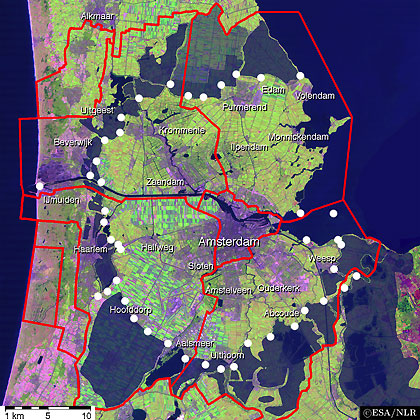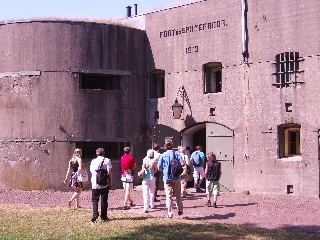 The Defence Line of Amsterdam ('Stelling van Amsterdam' in Dutch) is a 149 km long circular defence at 15-20 km around the capital Amsterdam which was constructed by the Ministry of War mostly between about 1881 and 1914.
The Defence Line of Amsterdam ('Stelling van Amsterdam' in Dutch) is a 149 km long circular defence at 15-20 km around the capital Amsterdam which was constructed by the Ministry of War mostly between about 1881 and 1914.
It consists of 3 to 5 km wide flooded areas (inundations) and thirty six forts, two coastal forts, two fortresses, four batteries and two coastal batteries. Additionally many more inlet sluices, secondary batteries and depots were constructed. This was all done to defend the National Keep, the last line of defence, of the Kingdom of the Netherlands.
Although back then not many inhabitants would have known much about the forts, the military presence in towns and in the rural areas must have been large and at the same time very common. Also the foreign threat by three superpowers surrounding The Netherlands: United Kingdom, Germany and France.
Because of advancing techniques of artillery, infantry, air planes, nuclear weapons and so on, the Defence Line lost its role in the Dutch defences. But also because of the disappearance of the foreign treat, which after World War II actually changed into a common defence.
 Even today the influence of the Defence Line is remarkable. The army is scarcely present but the country planning and infrastructure can largely be attributed to the Defence Line. Because of a special law, building along the Defence Line has hardly taken place and new rail and roadways had to run along the forts.
Even today the influence of the Defence Line is remarkable. The army is scarcely present but the country planning and infrastructure can largely be attributed to the Defence Line. Because of a special law, building along the Defence Line has hardly taken place and new rail and roadways had to run along the forts.
The Defence Line was inscribed to the UNESCO World Heritage List in 1996 because of its value for all mankind. In 2021 it was extended with the Nieuwe Hollandse Waterlinie (New Dutch Waterline) and the world heritage was given the name Dutch Water Defence Lines.
The forts are the most visible and fancy part. But more imagination is needed to see the Defence Line as a circle of flooded areas and as a logistical system. But if you don't, you will miss the essence of one of the worlds unique human works.
Presently the forts are being used for various purposes, like wine trading, child care and sports hooting. Biking and hiking trails show the visitor through the green belt around Amsterdam, which exists thanks to the Defence Line, along forts on which volunteers give guided tours.
This web-site is meant to provide insight and information about the "de Stelling van Amsterdam" (the Defence Line of Amsterdam) as a single unit. Hopefully you will enjoy this website and will see the area in a different perspective.
| Non-translated names. | |
|---|---|
| Names of towns etc. are not translated to English. The list below allows translation of parts of the name to help determining the meaning. | |
| along (the) | following name is often a waterway/river |
| berg | mountain, often hill |
| dam | dam in waterway |
| dijk | dike |
| dorp | village |
| meer | lake |
| near | following name is often a village |
| polder | reclaimed land |
| vaart | canal, waterway |
| weg | road |
